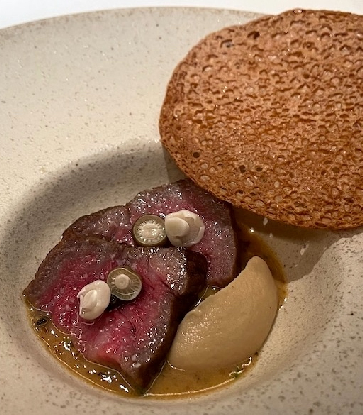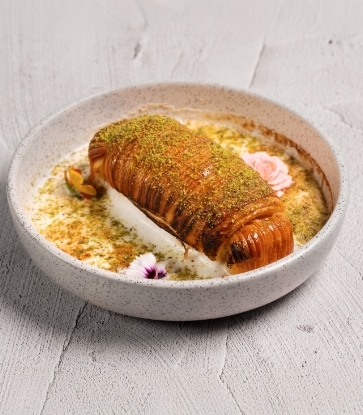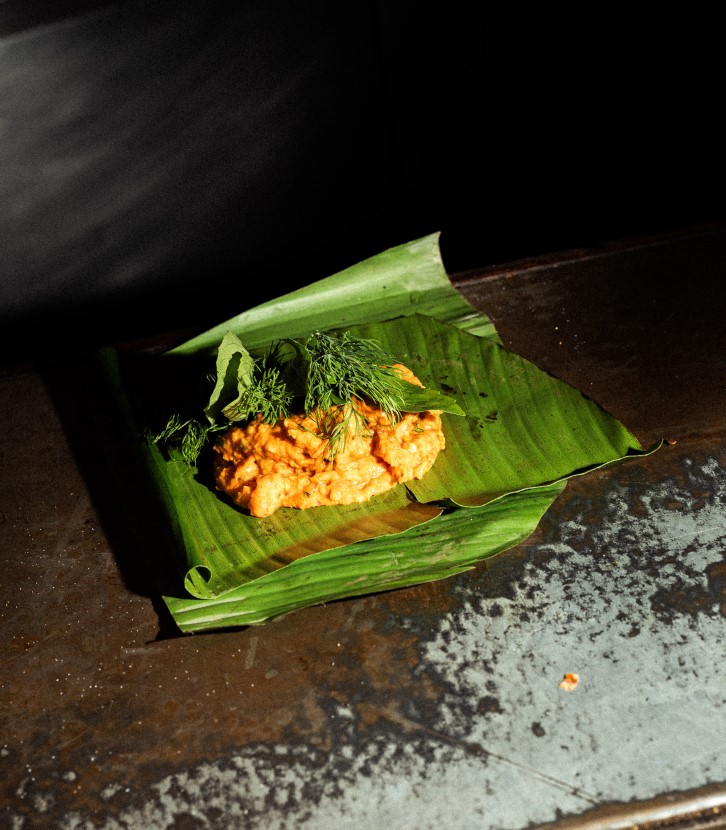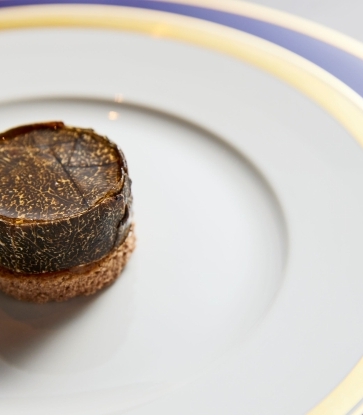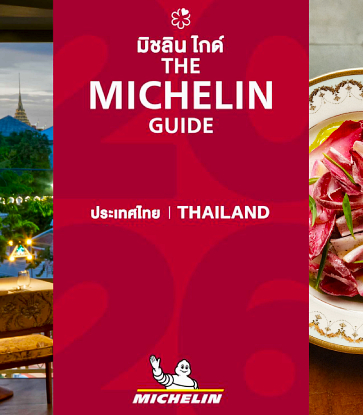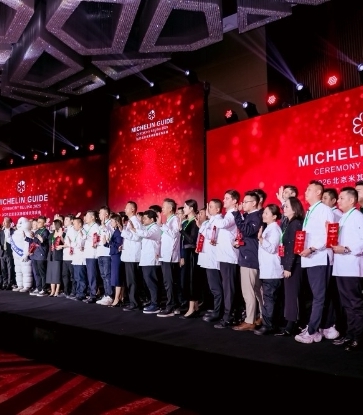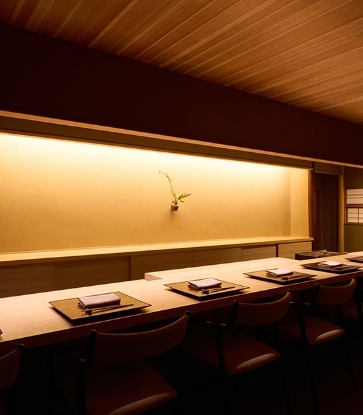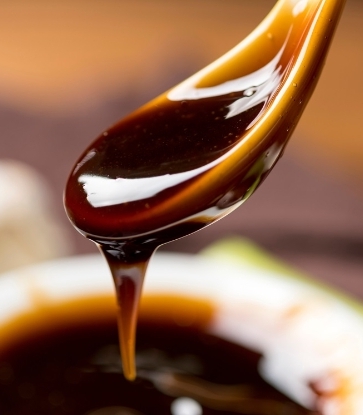When dining, a uniquely crafted bread course not only makes a strong first impression but also sets the stage for anticipation of the remaining courses. This explains why many chefs today focus not only on elevating the bread itself but also go the extra mile to improve the accompanying spreads.
Discover a holistic bread course experience at these six MICHELIN-Starred restaurants in Hong Kong, where both the bread and the spreads are meticulously prepared, making it one of the highlights of the entire dining experience.

Brioche with Fermented Tofu Butter
TATETwo MICHELIN Stars, MICHELIN Guide Hong Kong & Macau 2024
It is not uncommon to see guests take their time to appreciate the brioche paired with fermented tofu butter when presented at TATE. Like every detail in this two-MICHELIN-Starred restaurant, the bread and the butter are delicately shaped into perfect squares, exuding a sense of meticulous aesthetics.
RELATED: Video: Her Kitchen: Tate Dining Room

“The labour-intensive process of crafting bread daily demonstrates our unwavering commitment to quality and attention to detail, even for the most fundamental elements of the meal,” says Cheffe Vicky Lau (left image). At TATE, the brioche is made in-house daily with high-quality French flour and cultured French butter, kneaded over an extended period and undergoing a long proofing process before being placed in the oven. The result is bread whose structure and flavours are fully developed.
RELATED: Tate Chef Vicky Lau On Being 'Girly' In The Kitchen

Known for her strong interest in soy products, Lau also runs Mora, a one-MICHELIN-Starred and MICHELIN Green Star restaurant boasting a menu where soybeans take centre stage. It is not surprising then, that when she wanted to put a modern spin on the traditional brioche pairing, she created a unique fermented tofu butter spread. “The interplay between the rich, pillowy brioche and the tangy, savoury butter spread creates a harmonious balance of textures and tastes,” Lau shares.
RELATED: Small Great Things: The MICHELIN Green Star Restaurant Championing Sustainability with a Bean

Caraway Seed Bread with Le Tentation French Butter with Tonka Beans and Voatsiperifery Pepper
Cristal Room by Anne-Sophie PicOne MICHELIN Star, MICHELIN Guide Hong Kong & Macau 2024
“In recent years, the custom of haute cuisine has been to serve individual pieces of bread. But what I and our bakers wanted was to offer a whole loaf of bread, sliced. It gives a better ratio between the crust and the crumb. This decision also allows the textures and the aromas to develop,” Chef Anne-Sophie Pic says. In the tradition of French cuisine, bread is an integral part of the experience. This explains why bread has been treated as an individual dish in Pic’s restaurants.
RELATED: 9 Top Female Chefs To Celebrate This International Women’s Day

As bread is part of the meal, the choice of flour, like other ingredients, changes according to the seasons. For example, chestnut flour is being used in winter. As for the accompanying Le Tentation French Butter with Tonka Beans and Voatsiperifery Pepper, it reflects the philosophy of Pic’s cuisine: suffusion. “Suffusion is a process where an aroma passes from one product to another. Our butter is crafted using one of the ancestral techniques of perfumery named ‘enfleurage’, which is based on the absorption of flavour by a fatty substance,” Pic (right image) shares.
RELATED: 8 Types Of French Pastries To Know

Pic has observed that most of the guests do not dare to mop up the sauce left on the plate with their bread. “It’s encouraged in my restaurants!” Pic says warmly. “Sauce is the cornerstone of French cuisine, and thus, my work in the kitchen. Use the bread to sop up the sauce so you don’t lose any of the spirit of the dish.”
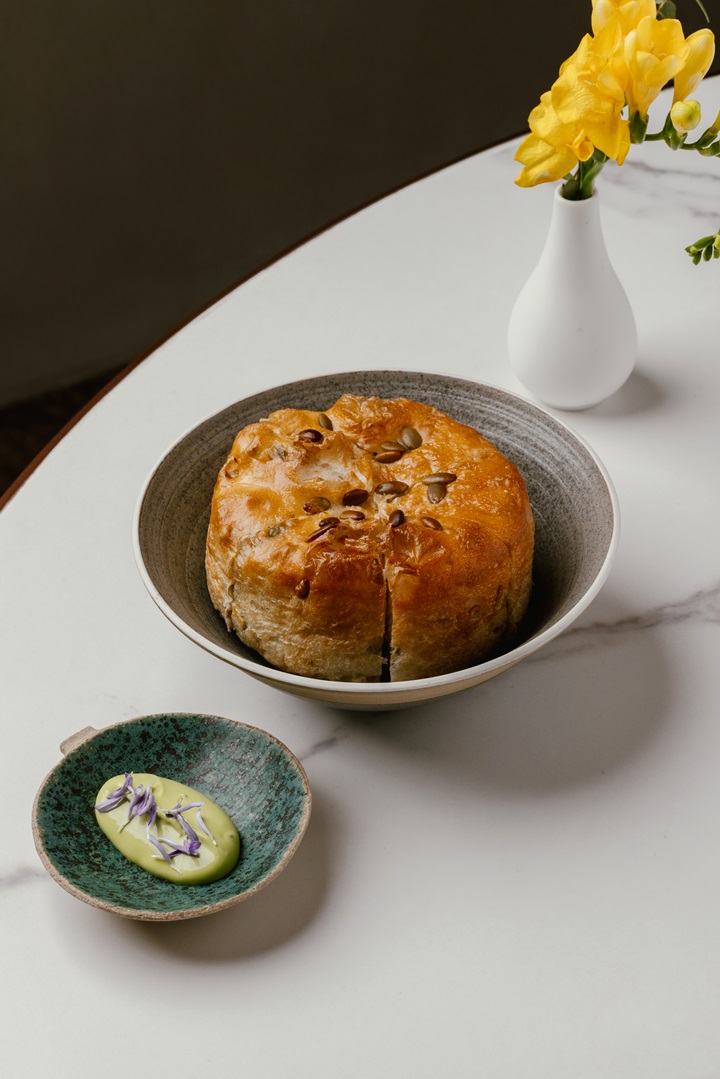
Feuille Bread with Dill Pil Pil
FeuilleOne MICHELIN Star and Green Star, MICHELIN Guide Hong Kong & Macau 2024
A brainchild of Chef David Toutain, who owns a two-MICHELIN-Starred restaurant that also has a MICHELIN Green Star in Paris, Feuille shares Toutain’s ethos in supporting sustainability and spares no effort in implementing eco-friendly practices. One of the examples that underlines this commitment at Feuille is their homemade bread spread "Dill Pil Pil".

Carrying a beautiful emerald colour, the Dill Pil Pil sauce is made with fish bones leftover from cooking other dishes in the restaurant.
The bones first undergo a slow cooking process to extract collagen, and the collagen is then combined with the homemade dill oil to become the creamy, herby bread spread. As for the bread, it follows Toutain’s exclusive recipe, which calls for French flour, organic pumpkin seeds, sunflower seeds, olive oil, fresh yeast, and poolish. The bread is always served hot and crispy, ensuring an optimal taste and texture. (Left image: Chef David Toutain (left) and Chef Joris Rousseau of Feuille)

“By replacing butter with Dill Pil Pil, we showcase our commitment to reducing waste and harnessing the full potential of ingredients. It also allows us to offer a unique and environmentally responsible dining experience to our guests,” shares Feuille’s Chef Joris Rousseau.
Not resting on their laurels, Rousseau already has plans to offer something different for the bread course. “One of our future plans involves exploring new techniques, such as cooking the bread on a fig leaf, to impart distinct flavours and aromas,” Rousseau says. “Bread holds a special place in French culinary culture. By highlighting the bread course, we pay homage to this important cultural aspect and endeavour to offer bread that elevates the entire dining experience.
RELATED: What is a MICHELIN Green Star?

Artisanal Bolivian Kiwicha Sourdough with Eva Aguilera’s Biodynamic Spanish Arbequina Olive Oil
MONOOne MICHELIN Star, MICHELIN Guide Hong Kong & Macau 2024
At MONO, the bread course always comes with a touch of storytelling. The thin string that ties the pre-cut sourdough slices together, for example, entails a great story that intrigues.
“In my South American culture, it is considered bad luck if the breadcrumbs are facing the ceiling or the sky — a superstition that possibly stems from the notion that grandma would become displeased if the bread's interior became dry. We therefore always tie the bread with a thin string,” says Chef Ricardo Chaneton, who hails from Venezuela and received training in French cooking, with a smile.
RELATED: First Day: Ricardo Chaneton of Mono Puts Latin American Cuisine On The Map

The olive oil that accompanies the bread is equally story-worthy. Painstakingly produced by artisan Eva Aguilera in a charming town in Catalonia, Spain, this Arbequina extra-virgin olive oil is selected for its exquisiteness.
“Eva believes that the full moon imparts a unique strength and power to the fruit. For that reason, she only harvests the olives during the full moon in November, resulting in exceptional olive oil.” Besides, this olive oil is highly limited in quantity — only 650 to 700 litres are produced each year. All of these factors combine to make every drop of this pure, golden liquid rare and precious. (left image: chef Ricardo Chaneton of MONO)
RELATED: Here's Why Asia is Becoming a Hotspot for Latin American Cuisine

To give the bread course its deserved recognition, Chaneton specially arranges for it to make an entrance in the middle of the meal, sometimes after the third course, sometimes after the fifth, in order to build up anticipation. For guests who would like to extend the experience at home, the sourdough and the artisanal olive oil are available for purchase from MONO's online shop.
RELATED: Ricardo Chaneton On His "Destiny" To Open Mono In Hong Kong

Mixed Seeds Sourdough with Chilli Espelette Smoked Butter
RacinesOne MICHELIN Star, MICHELIN Guide Hong Kong & Macau 2024
At Racines, the bread course is served with a sense of ritual. First, the warm sourdough, crafted by celebrated local artisanal bakery Levain Bakery, is placed in a linen bag surrounded by wheat and spelt to evoke the comfort of freshly baked dough. The restaurant logo, stamped with flour, lends a touch of rusticity to the presentation. Next, the butter is unveiled by one of the staff members lifting its lid, releasing a wisp of cherry-wood scented smoke and offering visual and gustatory pleasures.
RELATED: Technique Thursday: How To Make Your Own Sourdough Starter

“We serve the bread course at the beginning of the experience. We believe it allows our guests to relax and be prepared for the upcoming courses,” says Romain Dupeyre, one of the chefs and co-owners at Racines. Adrien Castillo, who co-founded and runs Racines with Dupeyre, shares that the message they want to convey through the choice of butter is their roots, specifically the South of France where they both originate.

“We choose a classic semi-salted butter and mix it with chilli Espelette powders from the Basque region in southwestern France. We deliberately shape it like a leaf to accentuate the concept of Racines, which means ‘root’ in French,” Castillo explains. “On the surface of the butter, we add a fine layer of jam made from dry plums native to the southwest region of France, and red port is added to enhance the flavour. To finish, we add a fresh pinch of chilli Espelette and infuse the butter with cherry wood smoke.” When tasted, the butter is spicy, sweet, and savoury all at once, giving the bread course a sophisticated taste.
Buah Keluak Brioche x Buah Keluak Emulsion
WheyOne MICHELIN Star, MICHELIN Guide Hong Kong & Macau 2024
“Unlike the traditional practices in Singapore, where bread is typically associated with curries and soups, we have chosen to elevate the bread course by showcasing its versatility and exploring new dimensions of flavour pairings,” says Chef Barry Quek. Whey has made a name for itself by enticing guests with its modern European dishes imbued with influences from Quek's native Singapore. Currently, the bread course is served in the midst of the meal as an individual course. When guests learn that the bread spread is made with Buah Keluak, a jet black nut that is unknown to many local guests, they immediately lean forward with curiosity and eagerness to know more. (Hero Image: Buah Keluak Brioche x Buah Keluak Emulsion at Whey)

Buah Keluak is the seed of the Pangium edule tree. Exuding a cacao and black olive fragrance, it is a cherished ingredient in Singapore, commonly used in making Nyonya-style curry dishes. “By incorporating Buah Keluak into our menu, we pay homage to the rich cultural tapestry of Singapore and showcase the diversity of our local culinary traditions,” Quek shares.
Crafting the spread takes time. The process begins by soaking the nuts in water for 4 days to soften them. The nuts are then cracked open, and the inner contents are used to culture the cream for a period of 7-10 days to allow the flavour to develop. As the final step, the cultured cream undergoes a whipping process, resulting in a luscious butter.

“The earthy and nutty note of the spread harmonises perfectly with the Buah Keluak brioche. Our guests often express their pleasant surprise at the inventive use of ingredients in the bread, as it introduces them to new and unexpected flavours,” Quek says with satisfaction.
RELATED: Industry Insiders : ZS Hospitality's Elizabeth Chu On Building Her Own Legacy



